A new proof for the security of the keyed sponge construction in the ideal compression function model
Trong bài báo này, chúng tôi đưa ra
một chứng minh mới cho độ an toàn của cấu trúc
Sponge có khóa. Phương pháp của chúng tôi sử
dụng kết quả trước đó về tính không phân biệt
được của cấu trúc Sponge. Theo cách tiếp cận
này, chúng ta có thể thấy mối liên hệ chặt chẽ về
độ an toàn của cấu trúc Sponge có khóa và phiên
bản nguyên thủy của nó
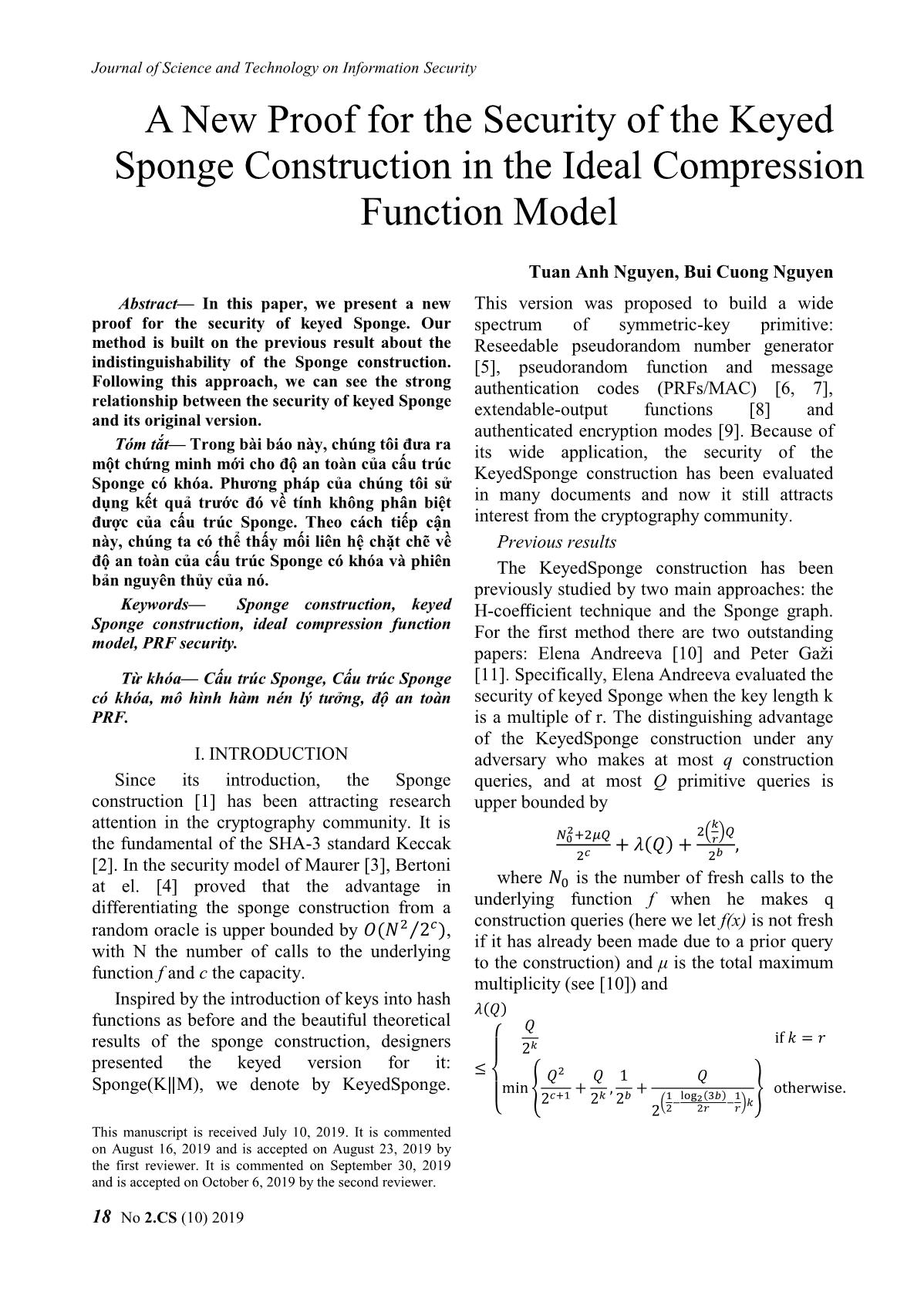
Trang 1

Trang 2
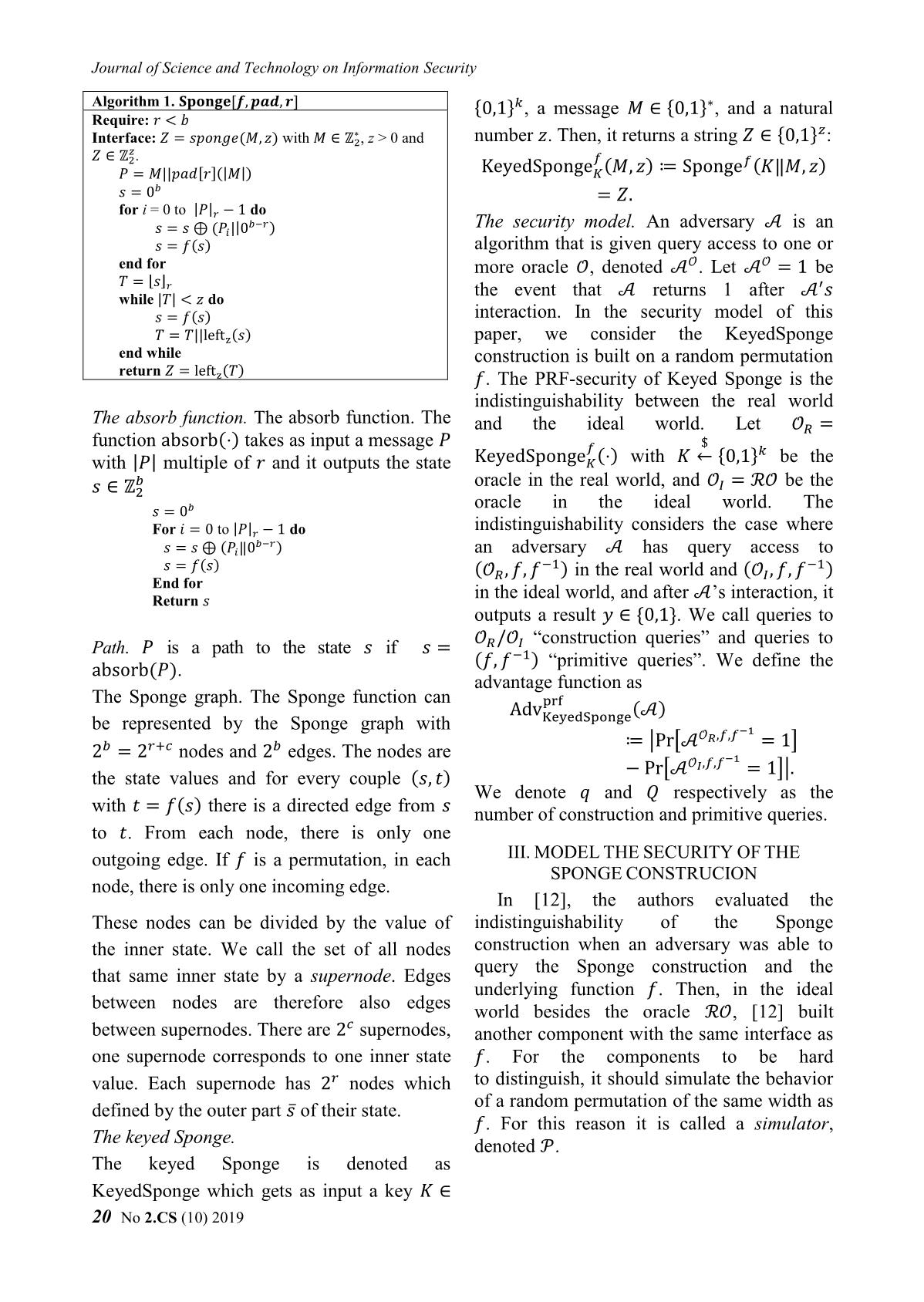
Trang 3
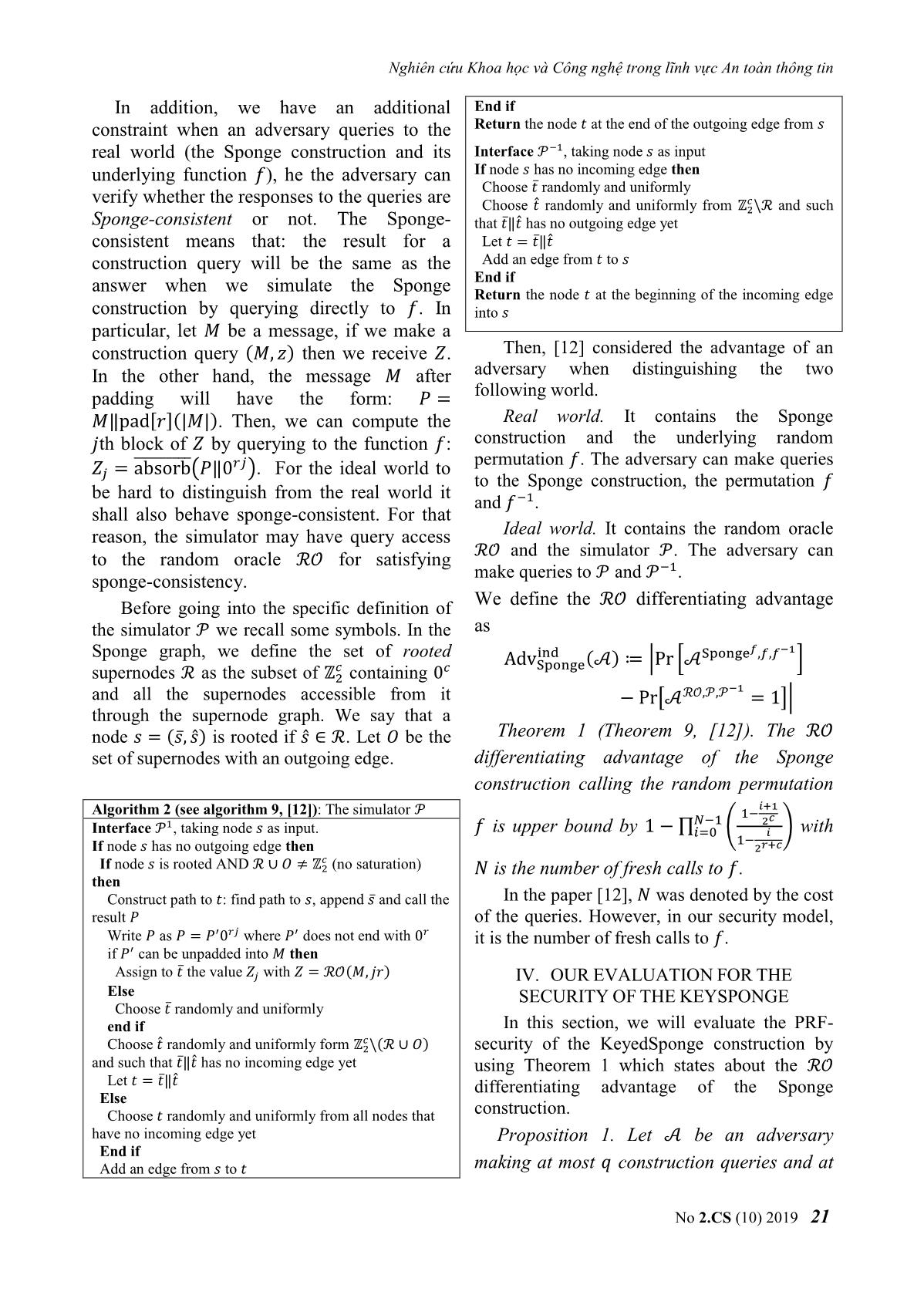
Trang 4
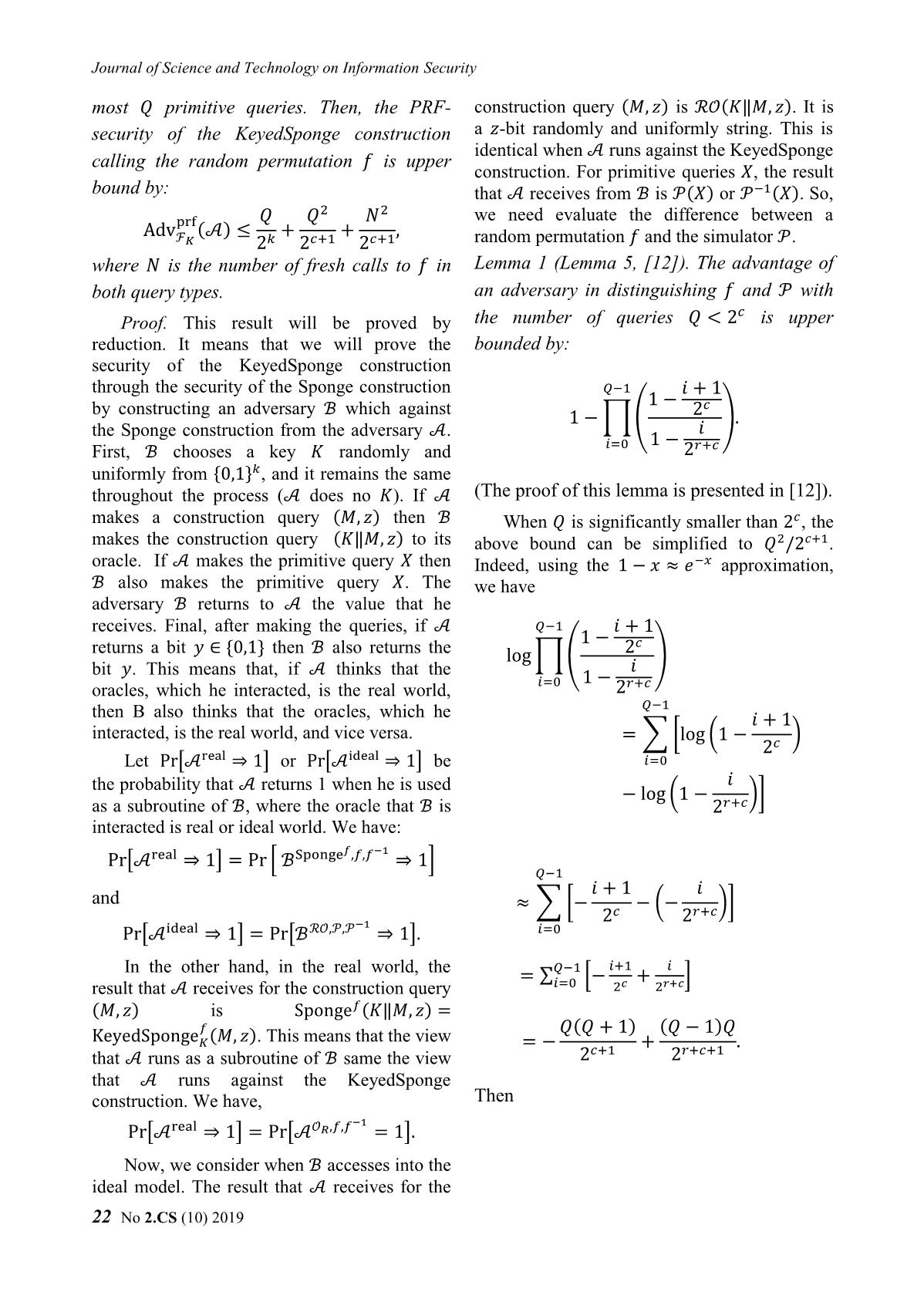
Trang 5
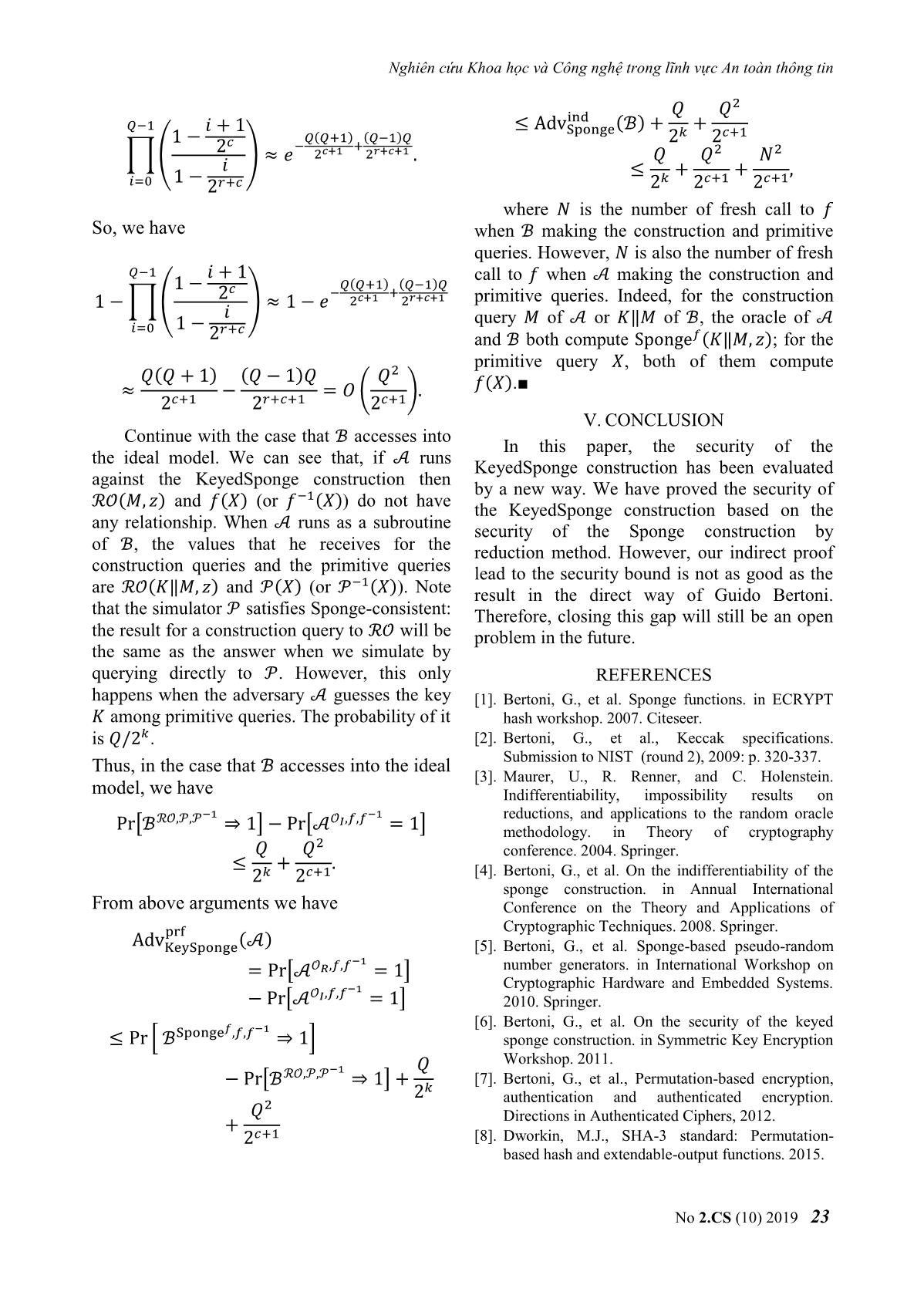
Trang 6
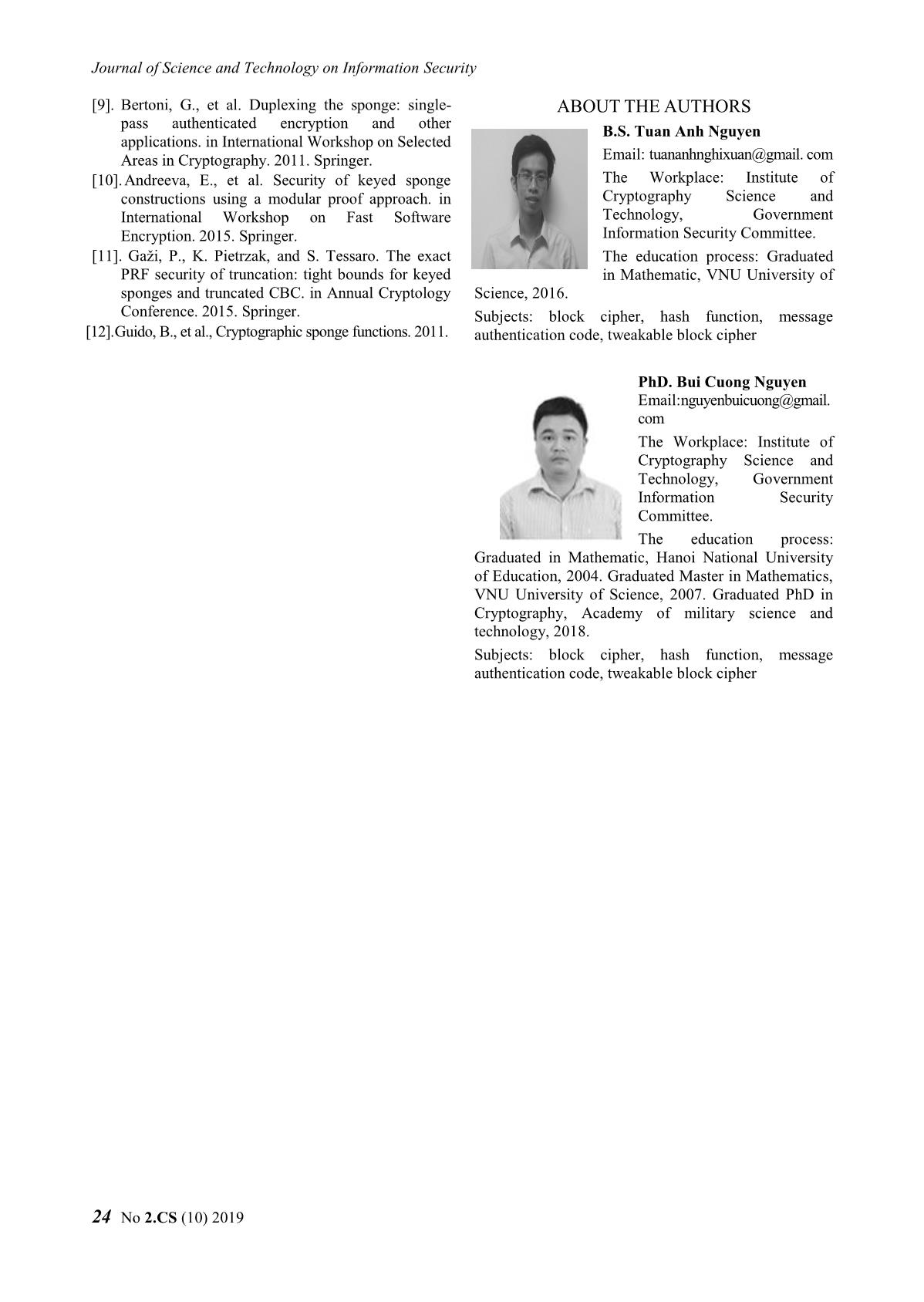
Trang 7
Bạn đang xem tài liệu "A new proof for the security of the keyed sponge construction in the ideal compression function model", để tải tài liệu gốc về máy hãy click vào nút Download ở trên
Tóm tắt nội dung tài liệu: A new proof for the security of the keyed sponge construction in the ideal compression function model
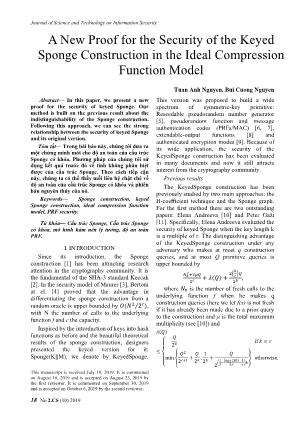
Journal of Science and Technology on Information Security
18 No 2.CS (10) 2019
Tuan Anh Nguyen, Bui Cuong Nguyen
Abstract— In this paper, we present a new
proof for the security of keyed Sponge. Our
method is built on the previous result about the
indistinguishability of the Sponge construction.
Following this approach, we can see the strong
relationship between the security of keyed Sponge
and its original version.
Tóm tắt— Trong bài báo này, chúng tôi đưa ra
một chứng minh mới cho độ an toàn của cấu trúc
Sponge có khóa. Phương pháp của chúng tôi sử
dụng kết quả trước đó về tính không phân biệt
được của cấu trúc Sponge. Theo cách tiếp cận
này, chúng ta có thể thấy mối liên hệ chặt chẽ về
độ an toàn của cấu trúc Sponge có khóa và phiên
bản nguyên thủy của nó.
Keywords— Sponge construction, keyed
Sponge construction, ideal compression function
model, PRF security.
Từ khóa— Cấu trúc Sponge, Cấu trúc Sponge
có khóa, mô hình hàm nén lý tưởng, độ an toàn
PRF.
I. INTRODUCTION
Since its introduction, the Sponge
construction [1] has been attracting research
attention in the cryptography community. It is
the fundamental of the SHA-3 standard Keccak
[2]. In the security model of Maurer [3], Bertoni
at el. [4] proved that the advantage in
differentiating the sponge construction from a
random oracle is upper bounded by 𝑂(𝑁2 2𝑐⁄ ),
with N the number of calls to the underlying
function f and c the capacity.
Inspired by the introduction of keys into hash
functions as before and the beautiful theoretical
results of the sponge construction, designers
presented the keyed version for it:
Sponge(K‖M), we denote by KeyedSponge.
This manuscript is received July 10, 2019. It is commented
on August 16, 2019 and is accepted on August 23, 2019 by
the first reviewer. It is commented on September 30, 2019
and is accepted on October 6, 2019 by the second reviewer.
This version was proposed to build a wide
spectrum of symmetric-key primitive:
Reseedable pseudorandom number generator
[5], pseudorandom function and message
authentication codes (PRFs/MAC) [6, 7],
extendable-output functions [8] and
authenticated encryption modes [9]. Because of
its wide application, the security of the
KeyedSponge construction has been evaluated
in many documents and now it still attracts
interest from the cryptography community.
Previous results
The KeyedSponge construction has been
previously studied by two main approaches: the
H-coefficient technique and the Sponge graph.
For the first method there are two outstanding
papers: Elena Andreeva [10] and Peter Gaži
[11]. Specifically, Elena Andreeva evaluated the
security of keyed Sponge when the key length k
is a multiple of r. The distinguishing advantage
of the KeyedSponge construction under any
adversary who makes at most q construction
queries, and at most Q primitive queries is
upper bounded by
𝑁0
2+2𝜇𝑄
2𝑐
+ 𝜆(𝑄) +
2(
𝑘
𝑟
)𝑄
2𝑏
,
where 𝑁0 is the number of fresh calls to the
underlying function f when he makes q
construction queries (here we let f(x) is not fresh
if it has already been made due to a prior query
to the construction) and μ is the total maximum
multiplicity (see [10]) and
𝜆(𝑄)
≤
{
𝑄
2𝑘
if 𝑘 = 𝑟
min {
𝑄2
2𝑐+1
+
𝑄
2𝑘
,
1
2𝑏
+
𝑄
2
(
1
2
−
log2(3𝑏)
2𝑟
−
1
𝑟
)𝑘
} otherwise.
A New Proof for the Security of the Keyed
Sponge Construction in the Ideal Compression
Function Model
Nghiên cứu Khoa học và Công nghệ trong lĩnh vực An toàn thông tin
No 2.CS (10) 2019 19
The distinguishing advantage of the
KeyedSponge was estimated by Peter Gaži has
upper bound:
𝑂 (
𝑞2 + 𝑞𝑄 + 𝑙𝑞
2𝑏−𝑧
) +
(
𝑘
𝑟)𝑁1
2𝑏
+min {
𝑁1
2
(
1
2
−
log2(3𝑏)
2𝑟
−
1
𝑟
)𝑘
,
𝑁1
2𝑘
+
𝑁1
2
2𝑐
},
where l is the maximum number of blocks in
each construction query, z (z<r) is the fixed
length of output and 𝑁1 = 𝑞𝑙 + 𝑄.
For the second method, Guido Bertoni [6]
uses the Sponge graph to directly evaluate the
security of the KeyedSponge construction. The
distinguishing advantage is upper bounded by:
𝑂 (
𝑁0
2
2𝑐
+
𝑁0𝑄
2𝑐
+
𝑄
2𝑘
).
In our knowledge, it is the best result ever.
Our contributions. In this paper, we give a
new proof for the security of the KeyedSponge
construction according to the second approach.
We evaluate it by using the security of the
Sponge construction. Our bound are:
𝑄
2𝑘
+
𝑄2
2𝑐+1
+
𝑁2
2𝑐+1
,
where N is the number of fresh calls to the
underlying function f when adversary makes
both construction queries and primitive queries.
Although this result is not as tight as Guido
Bertoni's, it shows a close relationship between
the security of the KeyedSponge and Sponge
construction.
Organization of the paper. After the
introduction, in Section 2 we present some
preliminaries. In Section 3, we recall the
security of the Sponge construction. In Section 4,
we evaluate the indistinguishability of the
KeyedSponge construction. Finally, some
conclusions are given in Section 5.
II. PRELIMINARIES
We denote the set of all finite strings of
arbitrary length by ℤ2
∗ , the set of infinite-length
bit strings is denoted by ℤ2
∞, the concatenation of
two strings x and y is denoted as x‖y. We let
left𝑧(𝑥) denote the z leftmost bits of x. We
denote the length in bits of a message x by |x|. The
number of r-bit blocks of x is denoted by |𝑥|𝑟.
Random oracle.
Let ℛ𝒪: ℤ2
∗ → ℤ2
∞ be a random oracle
which takes inputs of arbitrary but finite length
and returns random infinite strings, where each
output bit is selected uniformly and
independently for every input M.
We denote a call to ℛ𝒪 where the output is
truncated to its z first bits by 𝑍 = ℛ𝒪(𝑀, 𝑧).
Sponge construction.
The Sponge construction determines the
... ction. In the security model of this
paper, we consider the KeyedSponge
construction is built on a random permutation
𝑓. The PRF-security of Keyed Sponge is the
indistinguishability between the real world
and the ideal world. Let 𝒪𝑅 =
KeyedSponge𝐾
𝑓(⋅) with 𝐾 ←
$
{0,1}𝑘 be the
oracle in the real world, and 𝒪𝐼 = ℛ𝒪 be the
oracle in the ideal world. The
indistinguishability considers the case where
an adversary 𝒜 has query access to
(𝒪𝑅 , 𝑓, 𝑓
−1) in the real world and (𝒪𝐼 , 𝑓, 𝑓
−1)
in the ideal world, and after 𝒜’s interaction, it
outputs a result 𝑦 ∈ {0,1}. We call queries to
𝒪𝑅/𝒪𝐼 “construction queries” and queries to
(𝑓, 𝑓−1) “primitive queries”. We define the
advantage function as
AdvKeyedSponge
prf (𝒜)
≔ |Pr[𝒜𝒪𝑅,𝑓,𝑓
−1
= 1]
− Pr[𝒜𝒪𝐼,𝑓,𝑓
−1
= 1]|.
We denote 𝑞 and 𝑄 respectively as the
number of construction and primitive queries.
III. MODEL THE SECURITY OF THE
SPONGE CONSTRUCION
In [12], the authors evaluated the
indistinguishability of the Sponge
construction when an adversary was able to
query the Sponge construction and the
underlying function 𝑓. Then, in the ideal
world besides the oracle ℛ𝒪, [12] built
another component with the same interface as
𝑓. For the components to be hard
to distinguish, it should simulate the behavior
of a random permutation of the same width as
𝑓. For this reason it is called a simulator,
denoted 𝒫.
Algorithm 1. 𝐒𝐩𝐨𝐧𝐠𝐞[𝒇, 𝒑𝒂𝒅, 𝒓]
Require: 𝑟 < 𝑏
Interface: 𝑍 = 𝑠𝑝𝑜𝑛𝑔𝑒(𝑀, 𝑧) with 𝑀 ∈ ℤ2
∗ , z > 0 and
𝑍 ∈ ℤ2
𝑧.
𝑃 = 𝑀||𝑝𝑎𝑑[𝑟](|𝑀|)
𝑠 = 0𝑏
for i = 0 to |𝑃|𝑟 − 1 do
𝑠 = 𝑠 ⊕ (𝑃𝑖||0
𝑏−𝑟)
𝑠 = 𝑓(𝑠)
end for
𝑇 = ⌊𝑠⌋𝑟
while |𝑇| < 𝑧 do
𝑠 = 𝑓(𝑠)
𝑇 = 𝑇||leftz(𝑠)
end while
return 𝑍 = leftz(𝑇)
Nghiên cứu Khoa học và Công nghệ trong lĩnh vực An toàn thông tin
No 2.CS (10) 2019 21
In addition, we have an additional
constraint when an adversary queries to the
real world (the Sponge construction and its
underlying function 𝑓), he the adversary can
verify whether the responses to the queries are
Sponge-consistent or not. The Sponge-
consistent means that: the result for a
construction query will be the same as the
answer when we simulate the Sponge
construction by querying directly to 𝑓. In
particular, let 𝑀 be a message, if we make a
construction query (𝑀, 𝑧) then we receive 𝑍.
In the other hand, the message 𝑀 after
padding will have the form: 𝑃 =
𝑀‖pad[𝑟](|𝑀|). Then, we can compute the
𝑗th block of 𝑍 by querying to the function 𝑓:
𝑍𝑗 = absorb̅̅ ̅̅ ̅̅ ̅̅ ̅(𝑃‖0
𝑟𝑗). For the ideal world to
be hard to distinguish from the real world it
shall also behave sponge-consistent. For that
reason, the simulator may have query access
to the random oracle ℛ𝒪 for satisfying
sponge-consistency.
Before going into the specific definition of
the simulator 𝒫 we recall some symbols. In the
Sponge graph, we define the set of rooted
supernodes ℛ as the subset of ℤ2
𝑐 containing 0𝑐
and all the supernodes accessible from it
through the supernode graph. We say that a
node 𝑠 = (�̅�, �̂�) is rooted if �̂� ∈ ℛ. Let 𝑂 be the
set of supernodes with an outgoing edge.
Algorithm 2 (see algorithm 9, [12]): The simulator 𝒫
Interface 𝒫1, taking node 𝑠 as input.
If node 𝑠 has no outgoing edge then
If node 𝑠 is rooted AND ℛ ∪ 𝑂 ≠ ℤ2
𝑐 (no saturation)
then
Construct path to 𝑡: find path to 𝑠, append �̅� and call the
result 𝑃
Write 𝑃 as 𝑃 = 𝑃′0𝑟𝑗 where 𝑃′ does not end with 0𝑟
if 𝑃′ can be unpadded into 𝑀 then
Assign to 𝑡̅ the value 𝑍𝑗 with 𝑍 = ℛ𝒪(𝑀, 𝑗𝑟)
Else
Choose 𝑡̅ randomly and uniformly
end if
Choose �̂� randomly and uniformly form ℤ2
𝑐\(ℛ ∪ 𝑂)
and such that 𝑡̅‖�̂� has no incoming edge yet
Let 𝑡 = 𝑡̅‖�̂�
Else
Choose 𝑡 randomly and uniformly from all nodes that
have no incoming edge yet
End if
Add an edge from 𝑠 to 𝑡
End if
Return the node 𝑡 at the end of the outgoing edge from 𝑠
Interface 𝒫−1, taking node 𝑠 as input
If node 𝑠 has no incoming edge then
Choose 𝑡̅ randomly and uniformly
Choose �̂� randomly and uniformly from ℤ2
𝑐\ℛ and such
that 𝑡̅‖�̂� has no outgoing edge yet
Let 𝑡 = 𝑡̅‖�̂�
Add an edge from 𝑡 to 𝑠
End if
Return the node 𝑡 at the beginning of the incoming edge
into 𝑠
Then, [12] considered the advantage of an
adversary when distinguishing the two
following world.
Real world. It contains the Sponge
construction and the underlying random
permutation 𝑓. The adversary can make queries
to the Sponge construction, the permutation 𝑓
and 𝑓−1.
Ideal world. It contains the random oracle
ℛ𝒪 and the simulator 𝒫. The adversary can
make queries to 𝒫 and 𝒫−1.
We define the ℛ𝒪 differentiating advantage
as
AdvSponge
ind (𝒜) ≔ |Pr [𝒜Sponge
𝑓,𝑓,𝑓−1]
− Pr[𝒜ℛ𝒪,𝒫,𝒫
−1
= 1]|
Theorem 1 (Theorem 9, [12]). The ℛ𝒪
differentiating advantage of the Sponge
construction calling the random permutation
𝑓 is upper bound by 1 − ∏ (
1−
𝑖+1
2𝑐
1−
𝑖
2𝑟+𝑐
)𝑁−1𝑖=0 with
𝑁 is the number of fresh calls to 𝑓.
In the paper [12], 𝑁 was denoted by the cost
of the queries. However, in our security model,
it is the number of fresh calls to 𝑓.
IV. OUR EVALUATION FOR THE
SECURITY OF THE KEYSPONGE
In this section, we will evaluate the PRF-
security of the KeyedSponge construction by
using Theorem 1 which states about the ℛ𝒪
differentiating advantage of the Sponge
construction.
Proposition 1. Let 𝒜 be an adversary
making at most 𝑞 construction queries and at
Journal of Science and Technology on Information Security
22 No 2.CS (10) 2019
most 𝑄 primitive queries. Then, the PRF-
security of the KeyedSponge construction
calling the random permutation 𝑓 is upper
bound by:
Advℱ𝐾
prf(𝒜) ≤
𝑄
2𝑘
+
𝑄2
2𝑐+1
+
𝑁2
2𝑐+1
,
where 𝑁 is the number of fresh calls to 𝑓 in
both query types.
Proof. This result will be proved by
reduction. It means that we will prove the
security of the KeyedSponge construction
through the security of the Sponge construction
by constructing an adversary ℬ which against
the Sponge construction from the adversary 𝒜.
First, ℬ chooses a key 𝐾 randomly and
uniformly from {0,1}𝑘, and it remains the same
throughout the process (𝒜 does no 𝐾). If 𝒜
makes a construction query (𝑀, 𝑧) then ℬ
makes the construction query (𝐾‖𝑀, 𝑧) to its
oracle. If 𝒜 makes the primitive query 𝑋 then
ℬ also makes the primitive query 𝑋. The
adversary ℬ returns to 𝒜 the value that he
receives. Final, after making the queries, if 𝒜
returns a bit 𝑦 ∈ {0,1} then ℬ also returns the
bit 𝑦. This means that, if 𝒜 thinks that the
oracles, which he interacted, is the real world,
then B also thinks that the oracles, which he
interacted, is the real world, and vice versa.
Let Pr[𝒜real ⇒ 1] or Pr[𝒜ideal ⇒ 1] be
the probability that 𝒜 returns 1 when he is used
as a subroutine of ℬ, where the oracle that ℬ is
interacted is real or ideal world. We have:
Pr[𝒜real ⇒ 1] = Pr [ ℬSponge
𝑓,𝑓,𝑓−1 ⇒ 1]
and
Pr[𝒜ideal ⇒ 1] = Pr[ℬℛ𝒪,𝒫,𝒫
−1
⇒ 1].
In the other hand, in the real world, the
result that 𝒜 receives for the construction query
(𝑀, 𝑧) is Sponge𝑓(𝐾‖𝑀, 𝑧) =
KeyedSponge𝐾
𝑓(𝑀, 𝑧). This means that the view
that 𝒜 runs as a subroutine of ℬ same the view
that 𝒜 runs against the KeyedSponge
construction. We have,
Pr[𝒜real ⇒ 1] = Pr[𝒜𝒪𝑅,𝑓,𝑓
−1
= 1].
Now, we consider when ℬ accesses into the
ideal model. The result that 𝒜 receives for the
construction query (𝑀, 𝑧) is ℛ𝒪(𝐾‖𝑀, 𝑧). It is
a 𝑧-bit randomly and uniformly string. This is
identical when 𝒜 runs against the KeyedSponge
construction. For primitive queries 𝑋, the result
that 𝒜 receives from ℬ is 𝒫(𝑋) or 𝒫−1(𝑋). So,
we need evaluate the difference between a
random permutation 𝑓 and the simulator 𝒫.
Lemma 1 (Lemma 5, [12]). The advantage of
an adversary in distinguishing 𝑓 and 𝒫 with
the number of queries 𝑄 < 2𝑐 is upper
bounded by:
1 −∏(
1 −
𝑖 + 1
2𝑐
1 −
𝑖
2𝑟+𝑐
)
𝑄−1
𝑖=0
.
(The proof of this lemma is presented in [12]).
When 𝑄 is significantly smaller than 2𝑐, the
above bound can be simplified to 𝑄2/2𝑐+1.
Indeed, using the 1 − 𝑥 ≈ 𝑒−𝑥 approximation,
we have
log∏(
1 −
𝑖 + 1
2𝑐
1 −
𝑖
2𝑟+𝑐
)
𝑄−1
𝑖=0
= ∑ [log (1 −
𝑖 + 1
2𝑐
)
𝑄−1
𝑖=0
− log (1 −
𝑖
2𝑟+𝑐
)]
≈ ∑ [−
𝑖 + 1
2𝑐
− (−
𝑖
2𝑟+𝑐
)]
𝑄−1
𝑖=0
= ∑ [−
𝑖+1
2𝑐
+
𝑖
2𝑟+𝑐
]𝑄−1𝑖=0
= −
𝑄(𝑄 + 1)
2𝑐+1
+
(𝑄 − 1)𝑄
2𝑟+𝑐+1
.
Then
Nghiên cứu Khoa học và Công nghệ trong lĩnh vực An toàn thông tin
No 2.CS (10) 2019 23
∏(
1−
𝑖 + 1
2𝑐
1 −
𝑖
2𝑟+𝑐
)
𝑄−1
𝑖=0
≈ 𝑒
−
𝑄(𝑄+1)
2𝑐+1
+
(𝑄−1)𝑄
2𝑟+𝑐+1 .
So, we have
1 −∏(
1−
𝑖 + 1
2𝑐
1 −
𝑖
2𝑟+𝑐
)
𝑄−1
𝑖=0
≈ 1 − 𝑒
−
𝑄(𝑄+1)
2𝑐+1
+
(𝑄−1)𝑄
2𝑟+𝑐+1
≈
𝑄(𝑄 + 1)
2𝑐+1
−
(𝑄 − 1)𝑄
2𝑟+𝑐+1
= 𝑂 (
𝑄2
2𝑐+1
).
Continue with the case that ℬ accesses into
the ideal model. We can see that, if 𝒜 runs
against the KeyedSponge construction then
ℛ𝒪(𝑀, 𝑧) and 𝑓(𝑋) (or 𝑓−1(𝑋)) do not have
any relationship. When 𝒜 runs as a subroutine
of ℬ, the values that he receives for the
construction queries and the primitive queries
are ℛ𝒪(𝐾‖𝑀, 𝑧) and 𝒫(𝑋) (or 𝒫−1(𝑋)). Note
that the simulator 𝒫 satisfies Sponge-consistent:
the result for a construction query to ℛ𝒪 will be
the same as the answer when we simulate by
querying directly to 𝒫. However, this only
happens when the adversary 𝒜 guesses the key
𝐾 among primitive queries. The probability of it
is 𝑄/2𝑘.
Thus, in the case that ℬ accesses into the ideal
model, we have
Pr[ℬℛ𝒪,𝒫,𝒫
−1
⇒ 1] − Pr[𝒜𝒪𝐼,𝑓,𝑓
−1
= 1]
≤
𝑄
2𝑘
+
𝑄2
2𝑐+1
.
From above arguments we have
AdvKeySponge
prf (𝒜)
= Pr[𝒜𝒪𝑅,𝑓,𝑓
−1
= 1]
− Pr[𝒜𝒪𝐼,𝑓,𝑓
−1
= 1]
≤ Pr [ ℬSponge
𝑓,𝑓,𝑓−1 ⇒ 1]
− Pr[ℬℛ𝒪,𝒫,𝒫
−1
⇒ 1] +
𝑄
2𝑘
+
𝑄2
2𝑐+1
≤ AdvSponge
ind (ℬ) +
𝑄
2𝑘
+
𝑄2
2𝑐+1
≤
𝑄
2𝑘
+
𝑄2
2𝑐+1
+
𝑁2
2𝑐+1
,
where 𝑁 is the number of fresh call to 𝑓
when ℬ making the construction and primitive
queries. However, 𝑁 is also the number of fresh
call to 𝑓 when 𝒜 making the construction and
primitive queries. Indeed, for the construction
query 𝑀 of 𝒜 or 𝐾‖𝑀 of ℬ, the oracle of 𝒜
and ℬ both compute Sponge𝑓(𝐾‖𝑀, 𝑧); for the
primitive query 𝑋, both of them compute
𝑓(𝑋).■
V. CONCLUSION
In this paper, the security of the
KeyedSponge construction has been evaluated
by a new way. We have proved the security of
the KeyedSponge construction based on the
security of the Sponge construction by
reduction method. However, our indirect proof
lead to the security bound is not as good as the
result in the direct way of Guido Bertoni.
Therefore, closing this gap will still be an open
problem in the future.
REFERENCES
[1]. Bertoni, G., et al. Sponge functions. in ECRYPT
hash workshop. 2007. Citeseer.
[2]. Bertoni, G., et al., Keccak specifications.
Submission to NIST (round 2), 2009: p. 320-337.
[3]. Maurer, U., R. Renner, and C. Holenstein.
Indifferentiability, impossibility results on
reductions, and applications to the random oracle
methodology. in Theory of cryptography
conference. 2004. Springer.
[4]. Bertoni, G., et al. On the indifferentiability of the
sponge construction. in Annual International
Conference on the Theory and Applications of
Cryptographic Techniques. 2008. Springer.
[5]. Bertoni, G., et al. Sponge-based pseudo-random
number generators. in International Workshop on
Cryptographic Hardware and Embedded Systems.
2010. Springer.
[6]. Bertoni, G., et al. On the security of the keyed
sponge construction. in Symmetric Key Encryption
Workshop. 2011.
[7]. Bertoni, G., et al., Permutation-based encryption,
authentication and authenticated encryption.
Directions in Authenticated Ciphers, 2012.
[8]. Dworkin, M.J., SHA-3 standard: Permutation-
based hash and extendable-output functions. 2015.
Journal of Science and Technology on Information Security
24 No 2.CS (10) 2019
[9]. Bertoni, G., et al. Duplexing the sponge: single-
pass authenticated encryption and other
applications. in International Workshop on Selected
Areas in Cryptography. 2011. Springer.
[10]. Andreeva, E., et al. Security of keyed sponge
constructions using a modular proof approach. in
International Workshop on Fast Software
Encryption. 2015. Springer.
[11]. Gaži, P., K. Pietrzak, and S. Tessaro. The exact
PRF security of truncation: tight bounds for keyed
sponges and truncated CBC. in Annual Cryptology
Conference. 2015. Springer.
[12]. Guido, B., et al., Cryptographic sponge functions. 2011.
ABOUT THE AUTHORS
B.S. Tuan Anh Nguyen
Email: tuananhnghixuan@gmail. com
The Workplace: Institute of
Cryptography Science and
Technology, Government
Information Security Committee.
The education process: Graduated
in Mathematic, VNU University of
Science, 2016.
Subjects: block cipher, hash function, message
authentication code, tweakable block cipher
PhD. Bui Cuong Nguyen
Email:nguyenbuicuong@gmail.
com
The Workplace: Institute of
Cryptography Science and
Technology, Government
Information Security
Committee.
The education process:
Graduated in Mathematic, Hanoi National University
of Education, 2004. Graduated Master in Mathematics,
VNU University of Science, 2007. Graduated PhD in
Cryptography, Academy of military science and
technology, 2018.
Subjects: block cipher, hash function, message
authentication code, tweakable block cipher
File đính kèm:
 a_new_proof_for_the_security_of_the_keyed_sponge_constructio.pdf
a_new_proof_for_the_security_of_the_keyed_sponge_constructio.pdf

